Consumer awareness surrounding the damaging effects of forever chemicals, like PFOA, PFAS, and PTFE is on the rise. The problem for consumers is that cookware marketed as “teflon free” often contains PTFE, which we don’t want anywhere near our food. Here are 6 cookware choices that are both Teflon, and PTFE free.
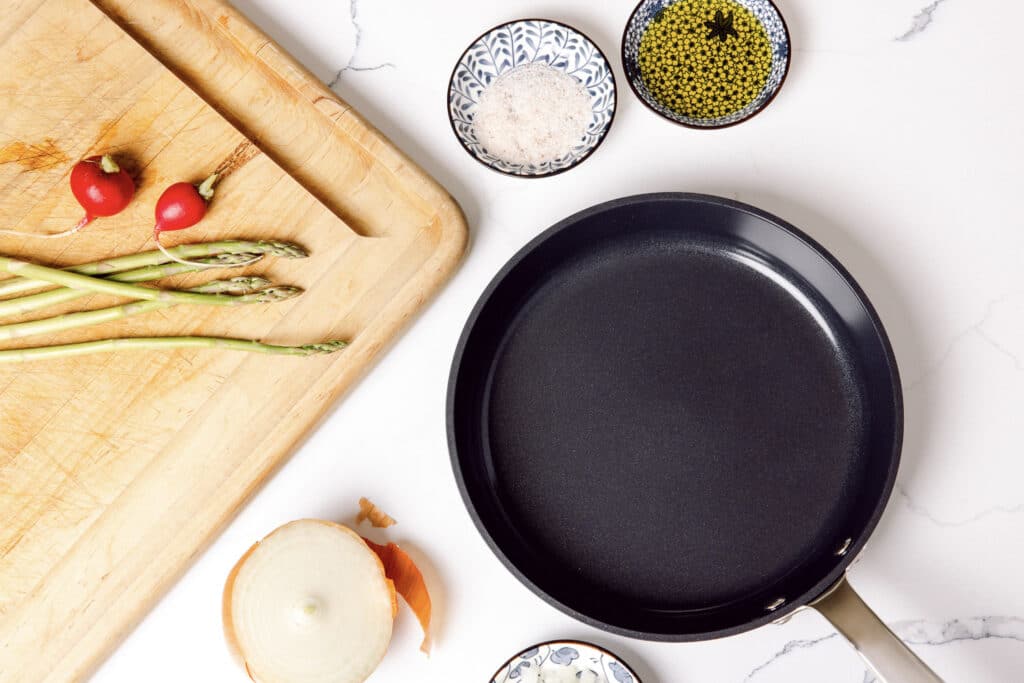
I have written extensively on LeafScore about the problem with forever chemicals, teflon, and even products marketed as “teflon-free cookware.”
Don’t be fooled by “Teflon-free”
The bottom line for consumers looking for truly non-toxic cookware is “teflon-free” marketing often means the swapping of PFOA for PTFE, which is still a forever chemical you and your family will want to avoid. In my review of Made In cookware, which makes some products that are non-toxic, but others coated with PTFE, I had this to say about the practice:
The main downside of Made In is that the company also sells non-stick cookware with PTFE. While it may be true that this type of PTFE surface outlasts most non-stick ceramic, it also poses a risk of toxic fumes if mishandled. And the surface is easily damaged by metal utensils or rough treatment.
LeafScore’s Made In Cookware Review
Eco-friendly cookware materials
When I emigrated to Canada, I gave away almost all of my cherished cookware because it was simply too heavy to justify shipping across the ocean. Starting again from scratch, on a freelance writer’s income and with no guarantee of permanent residency and citizenship, also made it hard to justify investing in top quality cookware. Thrift store and yard sale finds got me through that first year or so, but once I felt more settled, those scratched up pans with warped bottoms started to look less like a yard sale bargain and more like a real health hazard.
At LeafScore, we maintain a pros and cons list for each material known to be suitable for manufacturing eco-friendly cookware.
- Cast iron – see also: Is cast iron really environmentally friendly?
- Glass
- Carbon steel
- Ceramic
- Porcelain
- Aluminum
- Silicon
- Stainless steel
I’ve also looked at potential safety issues with artisanal cookware you might be tempted to buy from your farmers market or while on vacation. And check out how to test your cookware for lead and other chemicals of concern.
The best non-toxic cookware
Here are my top picks for the best eco-friendly cookware choices. Every cookware set on this list is PFOA, PFAS, and PTFE free. Curious about how we rate products? Click here to view our methodology, which at its core, is about voting with our dollars to fight climate change.
- Free of forever chemicals and heavy metals
- Third-party lab testing
- Super fun to cook with and looks great!
- Non-stick with proper seasoning
- Green packaging
- Lightweight and versatile
- Acacia wood handle means not oven-safe
- Handwash only
- Only three options currently: wok and frying pan
- Price: $79-$99
- Materials: Carbon steel, acacia wood handles
- Sizes: 8.5-inch, 9-inch, and 11-inch options
- Care: Handwash only
- Oven safe: No
- Country of Origin: China
The Forest cookware collection from Alva is a joy to cook with and looks fantastic. The blue carbon steel Wok and Frying Pan are light, versatile, and non-stick with proper seasoning. They’re also third-party tested for PTFE and other chemicals of concern, and Alva uses recycled materials and plastic-free shipping to make everything even more sustainable.
If you love the idea of cast iron, but want a wok or just a lighter frying pan, check out Alva’s Forest collection. It’s also well worth checking out the company’s Maestro, Chef, and Nori cookware collections too. These are all non-toxic, PTFE-free, and a blast to cook with (I’ve tested the Chef and Maestro collections personally). See our full review of Alva cookware for more details.
I love my Alva Forest Wok! It’s a lot lighter than cast iron and ceramic woks, super fun to cook with, and is a great size for not crowding out other pots and pans on the stove.
It also looks fabulous and feels perfectly balanced. The acacia wood handle stays cool and is easy to clean and firmly attached. The carbon steel itself is also super easy to clean and held its original seasoning for well over a month before I had to season it again. These pans can withstand rough handling and a good scrub and mine shows no signs of wear after six months of almost daily use.
With proper seasoning, this carbon steel wok and the Forest Frying Pan are as non-stick as it gets without PTFE. I’ve cooked up a variety of foods in it without anything getting stuck, including medium-firm tofu, which is notoriously fragile.
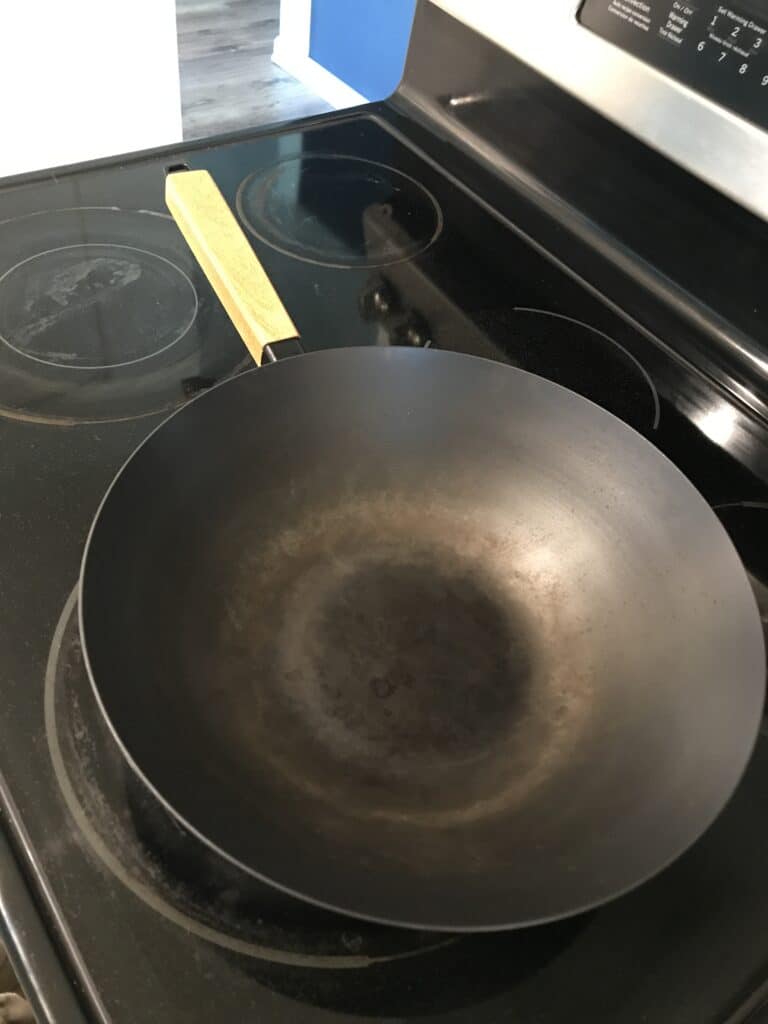
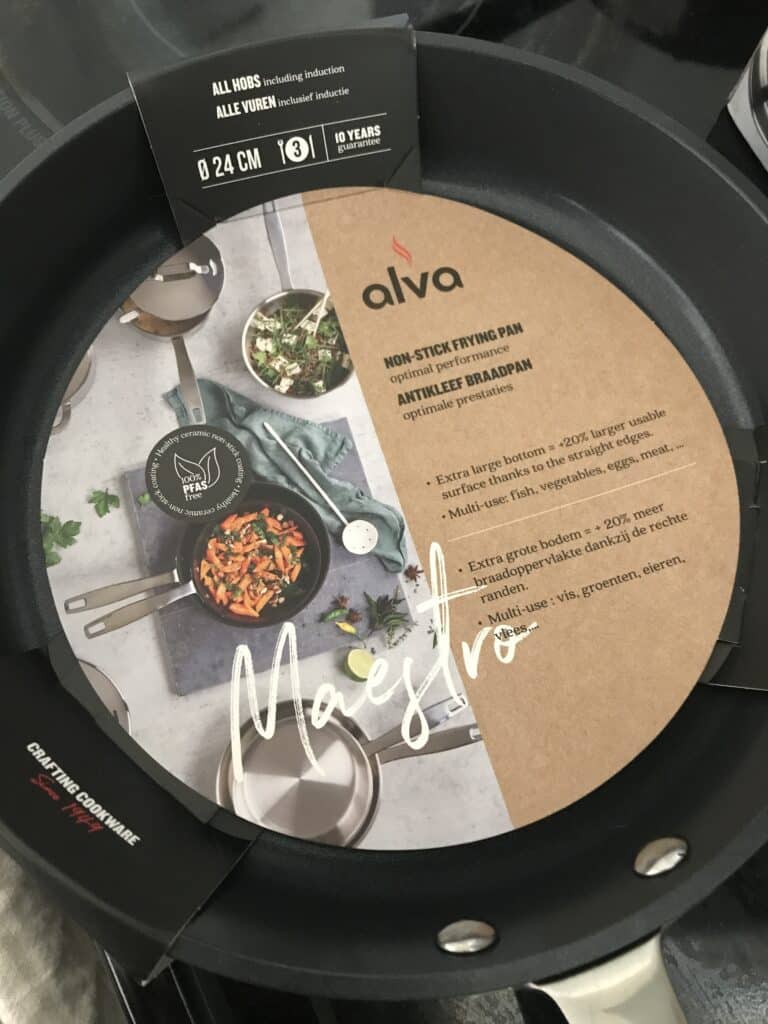
- Robust third-party testing for forever chemicals
- More affordable than competitors
- Well made, easy to cook with
- Works on induction cooktops
- Longer lasting non-stick ceramic coating
- Sustainable packaging
- Heavier than Caraway’s non-stick pans (a sign of quality but also tougher to maneuver)
- Only three fry pan sizes with non-stick coating
- Not dishwasher safe
- Oven-safe only to 200 F.
Alva’s Maestro collection is a great choice for cookware and the company also offers three frying pans with a non-toxic ceramic coating.
The frying pans are attractive, finely balanced, and truly non-stick. Better yet, they’re made using some recycled materials by a sustainable, longstanding Belgian cookware company. This pan is PFAS-free and does not leach any toxic chemicals or metals (I’ve seen the test results). You can use this pan in the oven up to 200 F, but it isn’t dishwasher safe.
Alva Cookware ships everything in recycled and recyclable packaging with minimal or no plastic.
The Maestro fry pan is available in three sizes and has straight sides to maximize cooking surface area. It is easy to clean, the stay-cool handle actually stays cool, and the pan works on all cooktops, including induction. The thick 3-ply stainless steel base with aluminum core makes for really even heat conductivity and it warms up fast too.
The Maestro frying pan is a joy to cook with. We’ve been using it for more than a year, almost daily, and my wife still comments on how great it is every time she uses it!
The pan is really well made, with a lovely balance between handle and pan. It is much easier to move around than solid ceramic or cast iron pans and you don’t need much oil to keep it non-stick.
Despite a few hard knocks, this pan has held up really well over several months. The non-stick coating has easily outlasted the Always Pan (see our review) which costs significantly more and isn’t as robustly made.
Read more about my experience with Alva Cookware here, and why I trust their test results.
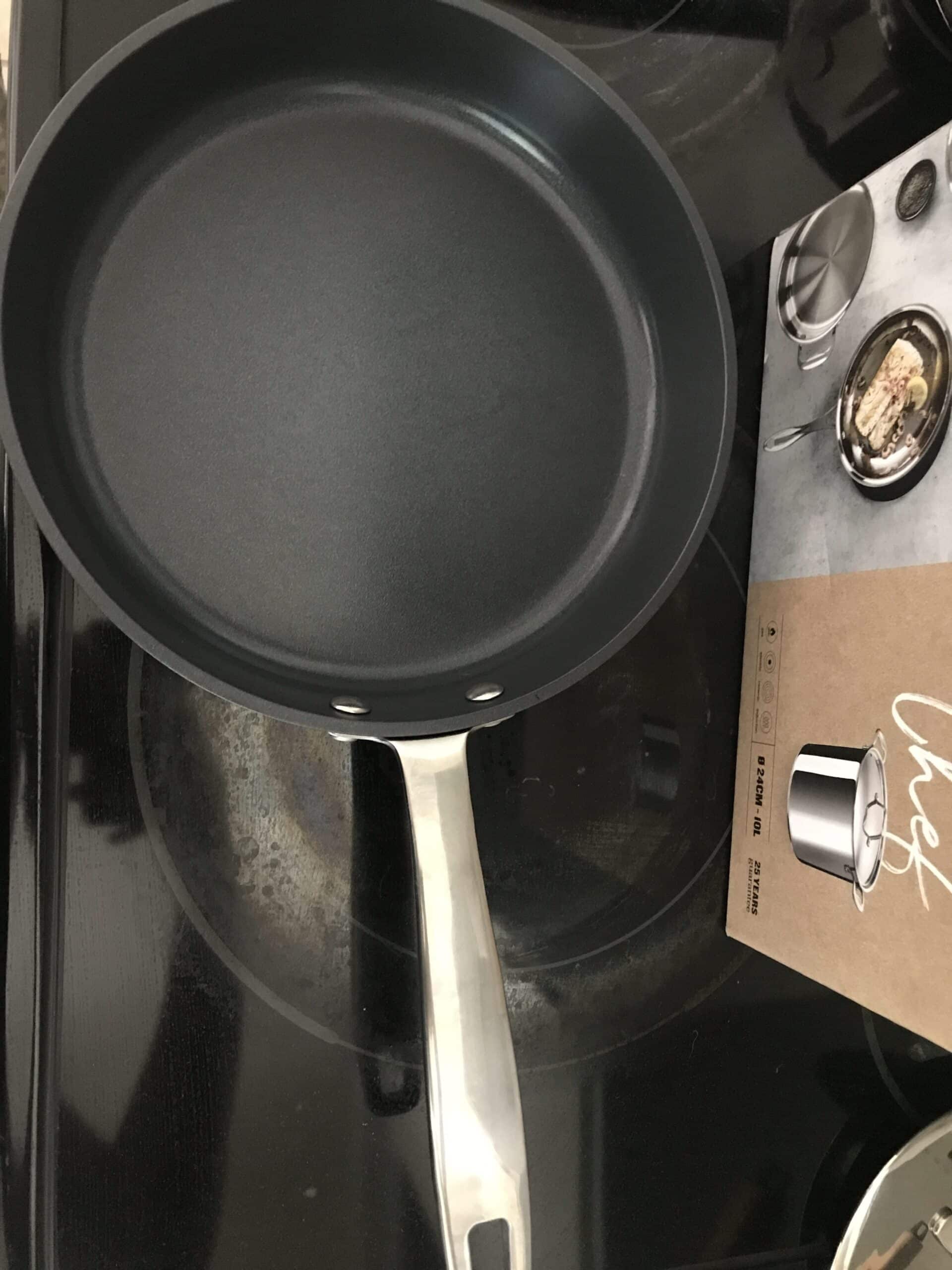
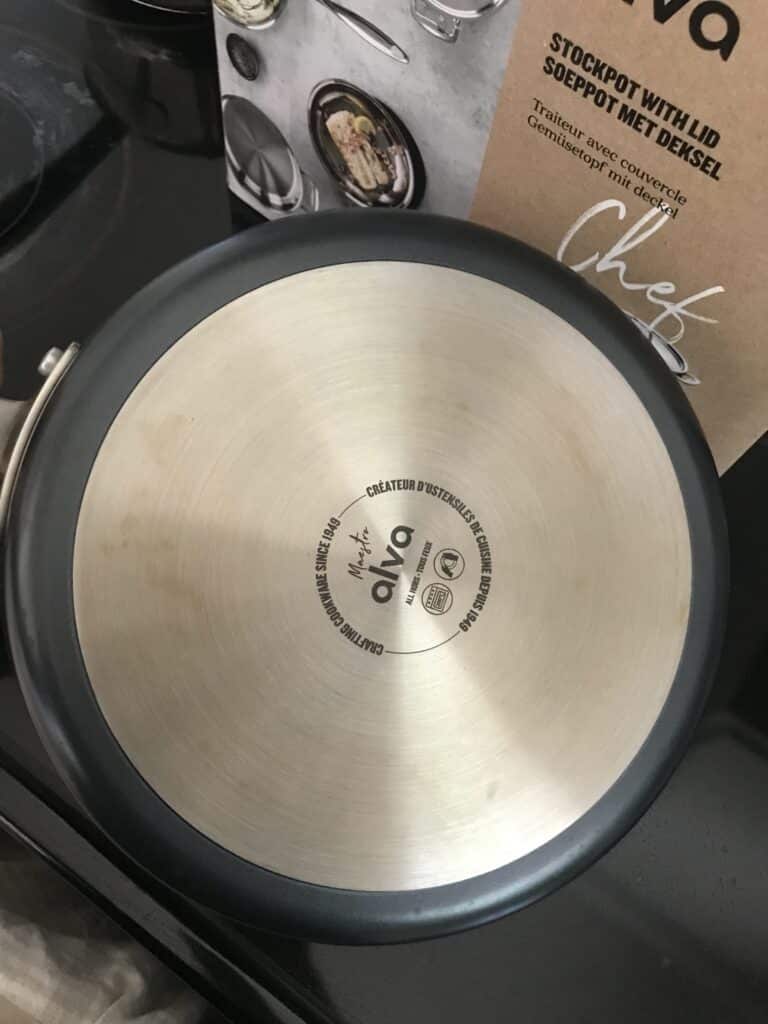
- Long-lasting if treated with care
- Non-toxic
- Lighter than cast iron
- Beautiful
- Carbon steel is very delicate and requires careful seasoning otherwise it will discolor instantly
De Buyer is a great brand for high quality non-toxic cookware. It offers beautiful, robust, hard-wearing carbon steel frying pans and a range of other quality kitchen items that are inexpensive, long-lasting, and easy to use (once you get the hang of basic cleaning and seasoning principles). The sturdy rivets help make sure that handle is going nowhere, but in case something does happen, the manufacturer offers a two-year warranty.
De Buyer cookware is lighter than cast iron but heavier than stainless steel or ceramic. It tends to lose its seasoning more easily than cast iron, but also puts on seasoning faster. De Buyer has been in the business of carbon steel for almost two centuries and still makes its products in France using traditional techniques.
This non-toxic cookware is surprisingly affordable, especially considering that a pan will last a lifetime if cared for properly.
As with the Made In line of cookware, De Buyer is another brand that feels high quality and ergonomic. The downside for us was how temperamental the De Buyer carbon steel can be. We effectively ruined a smaller De Buyer skillet with poor seasoning, a mistake some readers will inevitably repeat, and which will be frustrating. This is a line for expert chefs only.
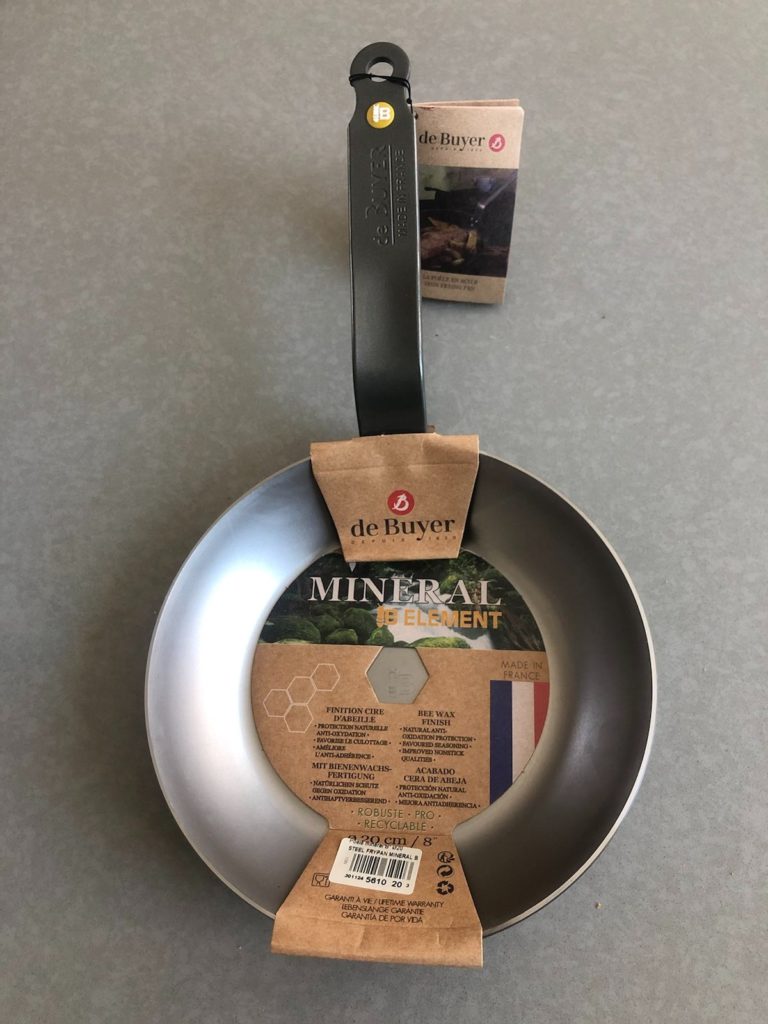
If you want the benefits of cast iron without the weight, carbon steel is an excellent choice for non-toxic, eco-friendly cookware. Carbon steel skillets are also a great option for cooks who like to flip and toss foods as they have sloped sides, unlike cast iron pans.
- Totally non-toxic
- Prop 65 certified
- Inexpensive
- Can pass down from generation to generation
- Not non-stick
- Heavy
- Tricky to clean
Lodge offer quality cast iron cookware from a trusted American brand, earning them a 5/5 rating from us. This company has been making cast iron cookware since 1896 and have you covered for pretty much every culinary need.
Want to grill some asparagus or halloumi? Check out the 10.25-inch square Grill Pan.
Lodge also offer an 8-inch pre-seasoned cast iron skillet with two lips for easy pouring and a handle loop so the pan can be hung for storage or decoration.
Some things we love about Lodge cast iron:
- Lifetime warranty
- Made in the US
- Works on all stovetops, campfire, barbecue, and in the oven
- Virtually indestructible
- Retains heat and seasoning well
- Has a naturally non-stick surface if you treat it right.
Lodge uses cast iron from two foundries on the banks of the Tennessee River in the small town of South Pittsburg, Tennessee. This makes it an attractive choice for U.S. customers wanting to support local business and avoid the environmental toll of importing heavier cookware from farther afield. Lodge cast iron is also California Prop 65 certified and US FDA certified for 7.5.1.4a Leachability of Lead and Cadmium for Glazed Ceramic Surfaces. Their silicone products (like pan handle covers) are certified by suppliers to be both BPA(Bisphenol A) and phthalate free.
An old Lodge Cast Iron Skillet, as well as one of their mini-models, is a staple in our home kitchen. We’ve used these pans for years, and love their ability to season over time. The downsides are the weight, cast iron is very heavy, so much so that it will be a deal breaker for some, plus the cleaning takes getting used to. Unlike Caraway, or other non-stick pan, a Lodge skillet will flat out rust if left to soak overnight.
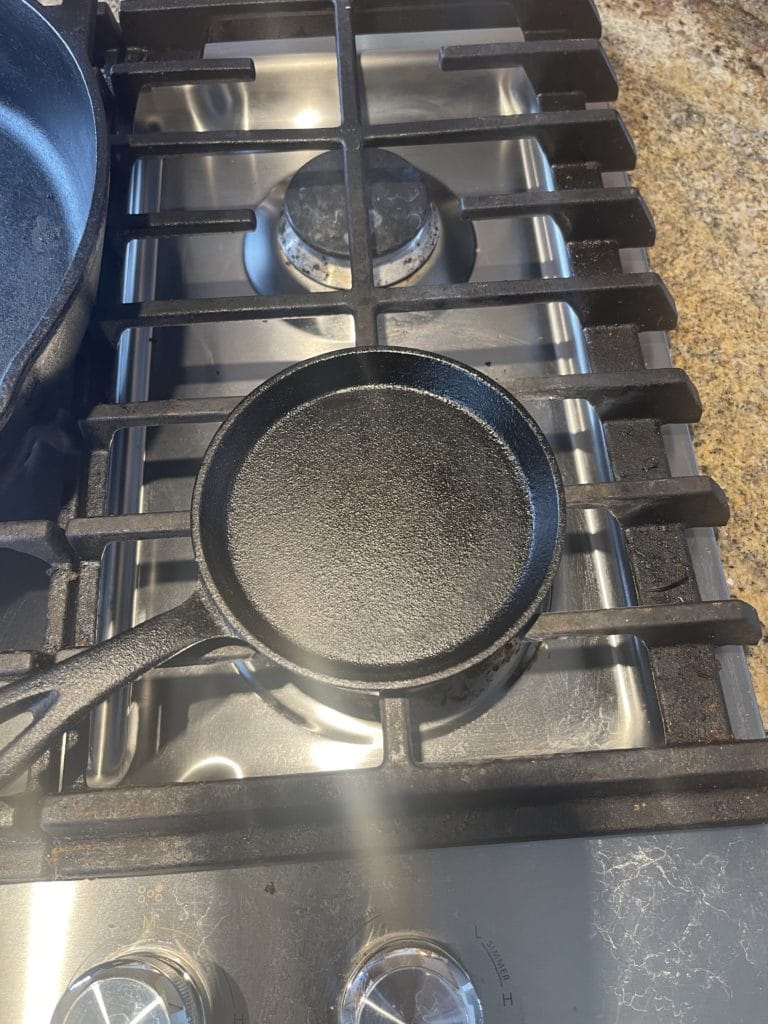
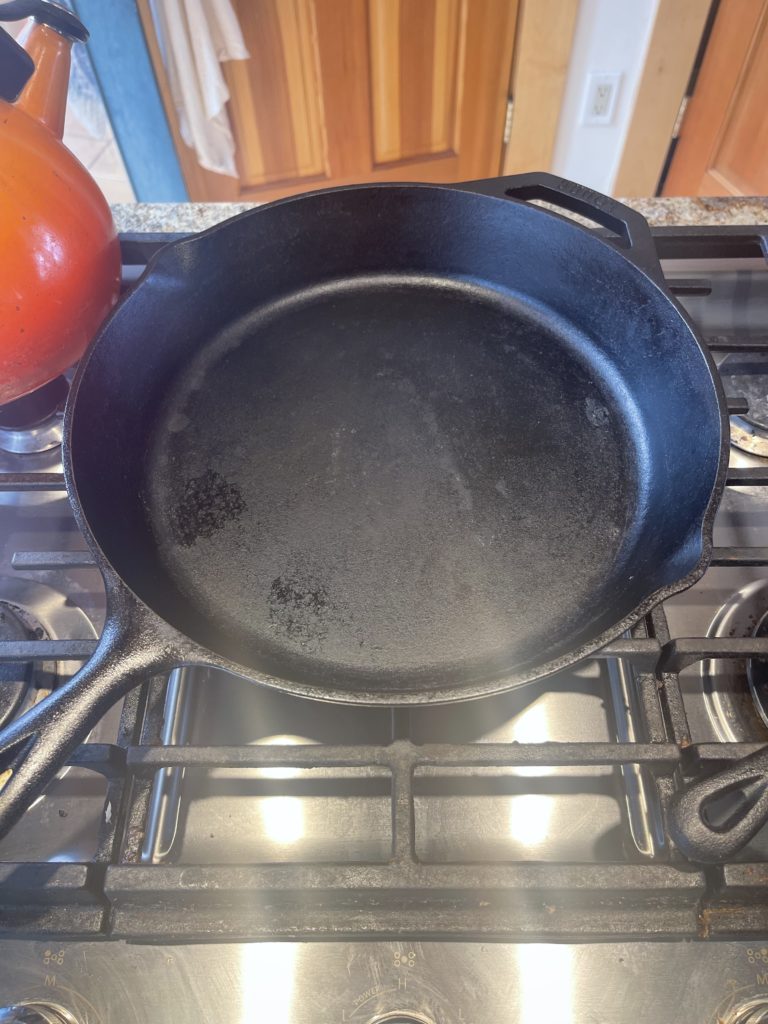
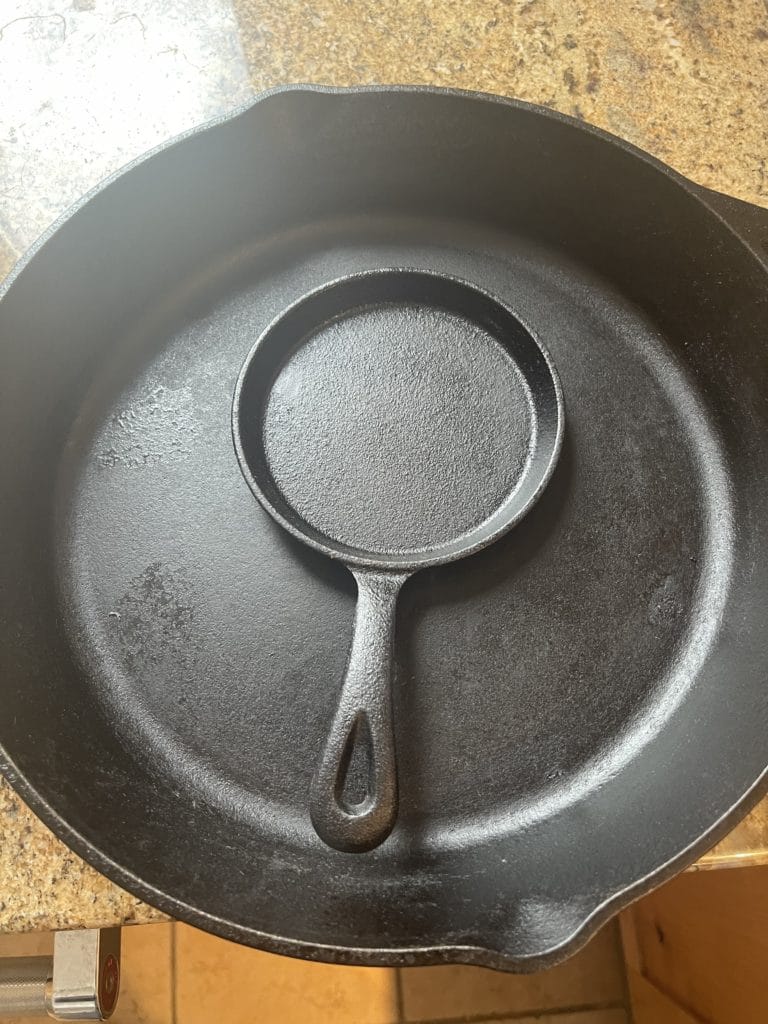
- Free of forever chemicals and heavy metals
- Provided third-party lab testing
- Very convenient
- Non-stick
- Green packaging
- Lightweight
- Nice color options
- Discolors over time
- Coating can scratch with use
- Not built to hand down to future generations. After using the products for a year, we are concerned with longevity.
Caraway makes beautiful ceramic-coated cookware that is third-party tested for PFAS, lead, cadmium, and other chemicals of concern. The company is transparent and sent me copies of its test results when I reached out. It was the third-party lab testing that earned Caraway 4-leaves from LeafScore, despite some rumblings on the blogosphere about the existence of heavy metals in at home tests.
Everything passed, meaning this is truly non-toxic non-stick cookware you can feel good about.
The pots and pans comprise smooth ceramic-coated aluminum with a steel bottom. This means the cookware is lighter than cast iron or carbon steel but still works on induction cooktops. It’s also oven-safe and easy to clean, requiring minimal oil for cooking.
The Caraway Cookware Set includes:
- Unique Caraway Storage Sytem
- 10.5 inch Fry Pan (see review here)
- 3 qt Sauce Pan
- 4.5 qt Sauté Pan
- 6.5 qt Dutch Oven
Caraway made the smart decision to go Dutch on the lid for the Dutch Oven and Sauce Pan (i.e., these share a lid, minimizing material use and cupboard space). Caraway also includes its unique storage system with every cookware set (Note: you can’t buy this separately, so if you want it, you’ll want to buy the complete set).
We also like that Caraway ships its products without any single-use plastics. Instead, it uses recycled and recyclable cardboard and reusable cork trivets.
These pots and pans are stunning our of the box and available in various colors, meaning there’s one bound to suit your kitchen aesthetic. Be aware, however, that Caraway cookware will discolor soon after use. After about one year especially, the cookware won’t look as it does fresh out of the box. And because the cookware comprises ceramic coated aluminum, rather than 3-ply or 5-ply stainless steel, you’ll want to replace Caraway Home pots and pans as soon as significant surface wear or chipping occurs, so as to avoid aluminum leaching into your food.
The company also offers top-quality non-toxic bakeware.
Readers who read our new Caraway cookware review will know we have tested this brand extensively, and as I alluded to above, we have reviewed third-party testing that confirms the products are PFOA, PFAS, and PTFE free.
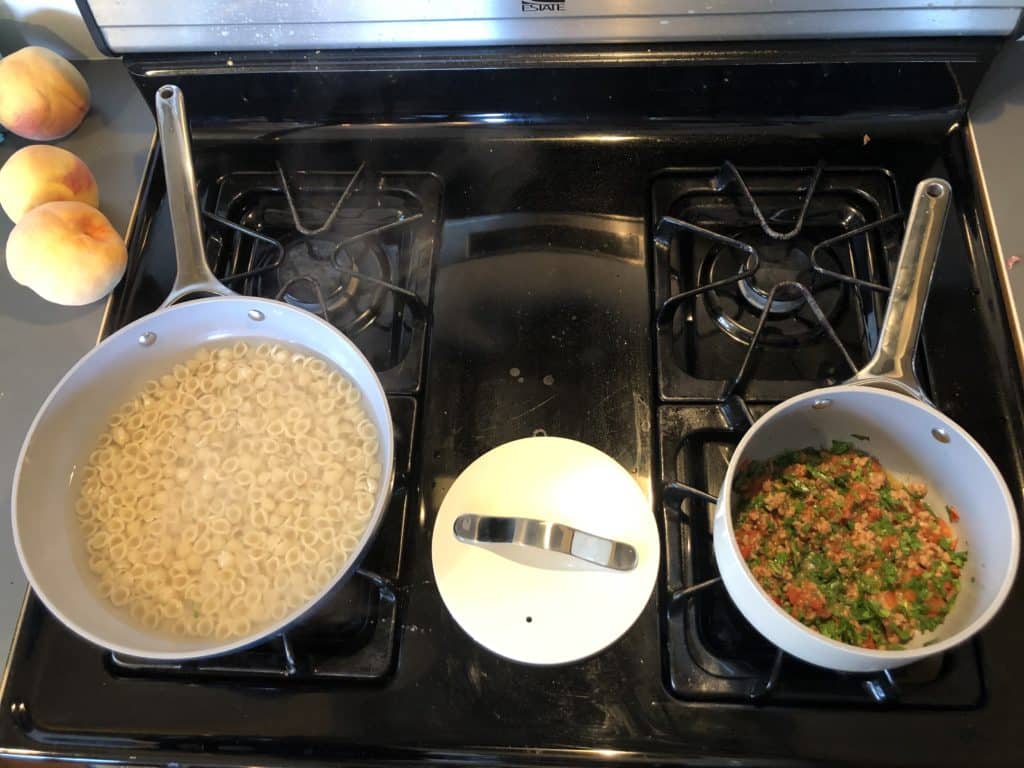
- Triple-ply construction
- Oven safe and dishwasher safe
- Easier to handle than cast iron
- PFOA, PTFE, and PFOAS free
- Lifetime warranty
- Compatible with all stovetops
- Not non-stick
Deluxe cookware for home chefs in the know, Cuisinart’s 12-piece 18/10 stainless steel set has your covered for almost all your cooking needs. Earning ⅘ leaves, Cuisinart’s Multiclad offers triple-ply stainless steel construction with magnetized stainless steel, aluminum core, and 18/10 stainless steel.
If you’re kitting out a new kitchen, or looking for a comprehensive replacement cookware set, the Cuisinart Multiclad Pro 12-Piece Stainless Steel Cookware Set is ideal.
This cookware is an excellent choice for novice and professional cooks alike.
The triple-ply construction grants excellent heat conductivity while using less energy. The Multiclad cookware is oven-safe up to 550 F and compatible with induction stoves.
The handles are riveted to the body of the pans, making for sturdy, reliable construction. The lids are tightfitting, so you can keep steam, flavor, and aroma where you want it. Tapered rims and cool-grip handles make for easier pouring.
If you’re looking for high-quality stainless-steel cookware, Cuisinart’s Multiclad is just the ticket. It’s a lot lighter and easier to handle than cast iron or carbon steel, won’t chip of break like some ceramics, and poses no risk of off-gassing or leaching toxic chemicals into food, unlike PTFE-coated and other non-stick cookware.
Free eBook: Simple Steps to a Greener Home
Concerned about climate change? Learn actionable tips for making each room in your home greener.
"*" indicates required fields

Bonus Picks!
While the cookware collections above are our top picks, there are a few other contenders worth considering. These tend to be a bit less durable and versatile overall, but might be exactly what you’re looking for in your eco-kitchen.
Xtrema is offering LeafScore readers 10% off their purchase using coupon code LEAFSCORE at checkout!
- Built with care to last for years
- Transparent with third-party lab testing
- PFOA, PFAS, and PTFE free
- Safe for the dishwasher, oven, stovetops, and fridge/freezer
- Beautiful aesthetic
- Meets California prop 65 standards
- Heavy
- Conducts heat poorly
- Made in China
- Won’t work on induction stoves
If you’re looking for the best, most eco-friendly, non-toxic ceramic cookware set, check out Xtrema®.
These pots and pans contain no:
- Leachable heavy metals
- PFOA or PTFE
- Glues
- Polymers
- Coatings or dyes.
Every shipment is inspected and tested for extractable heavy metals. Xtrema® cookware is FDA-approved and meets California Prop 65 standards, meaning that it is certified free from over 800 problematic compounds.
Xtrema® cookware is more environmentally-friendly than most cookware as it is created using renewable raw materials and green manufacturing practices.
With Xtrema® ceramic cookware, you can cook food easily on a low heat, because pure ceramic retains heat better than other cookware and helps food to cook evenly, inside and out. Just be sure to warm pans slowly and keep temperatures low to moderate (and add you oil after the pan is warmed).
While Xtrema® cookware is not non-stick, the smooth, non-porous, ceramic glaze makes for easy cooking once you’re used to cooking on low to moderate heat. Xtrema® is also super easy to clean. If food does stick, it’s safe to use abrasive cleaners such as steel wool, baking soda, and even Ajax without risk of scratching the surface.
We tested Xtrema cookware in our home kitchen. In the photos below, we make our favorite chicken curry recipe in the Xtrema Wok. In our tests, Xtrema cookware conducted heat poorly.
Note, too, that because it is pure ceramic, Xtrema cookware doesn’t work with induction cooktops.
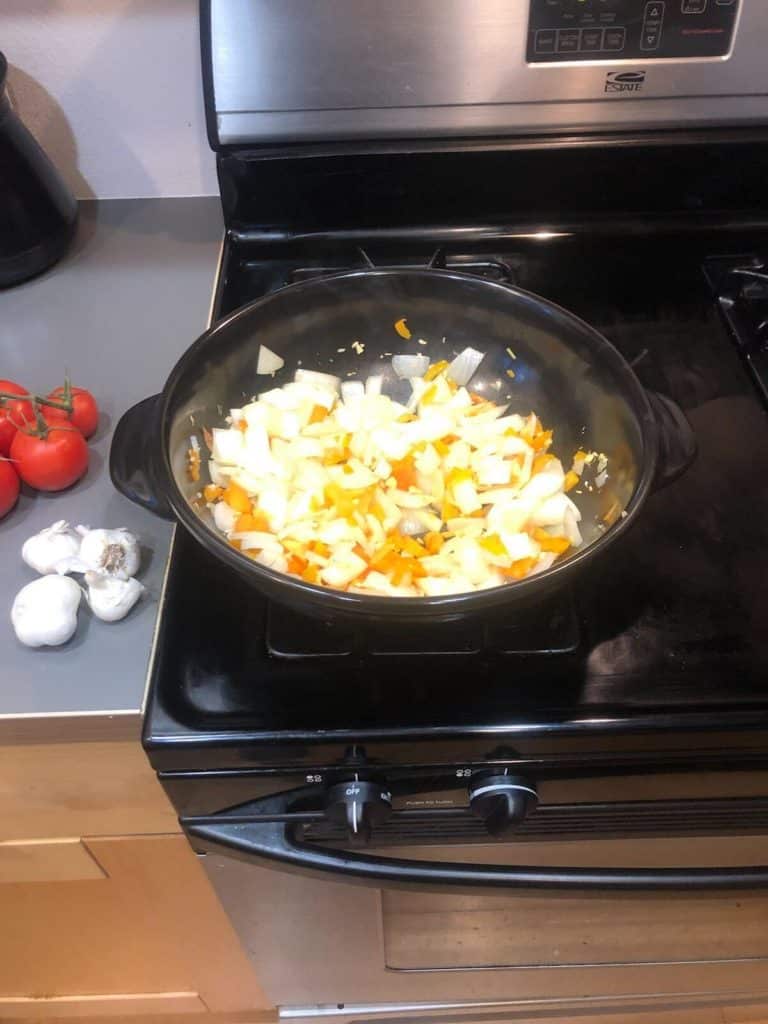
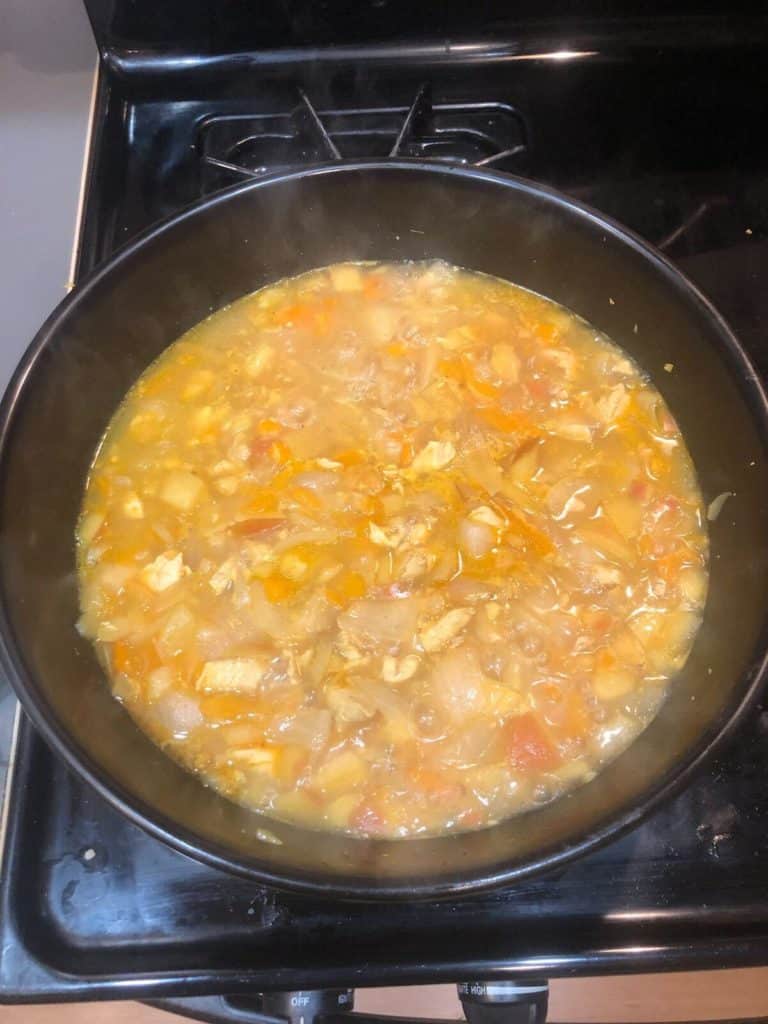
- Pure ceramic
- Made in USA
- Easy to clean
- Non-toxic
- Non-reactive to acidic foods
- Can be used to cook, serve, and store food
- Somewhat fragile
Traditional, non-toxic, thermal shock-resistant ceramic cookware with 5/5 leaves, pure ceramic CorningWare is made in the USA and remains a great choice for eco-friendly, non-toxic cooking. While not exactly the same as the original CorningWare Pyroceram, the new CorningWare® (which is actually stoneware) shares many of the benefits.
Most CorningWare® can’t be used on a stovetop, though, and has a much lower tolerance for thermal shock (don’t put a frozen dish directly in the oven!). There is, however, a stovetop-safe line manufactured in France by Keraglass/Eurokera for Corelle Brands.
If you are looking for pure ceramic cookware to use on a stovetop, go for CorningWare (made prior to 2000), or CorningWare®’s stovetop range made after 2008. Alternatively, check out the Emile Henry range of ceramic cookware.
- Stovetop compatible (some cookware only)
- Long-lasting
- Ceramic inside and out
- Non-reactive to acidic foods
- Resistant to thermal shock (some cookware only)
- Dishwasher and microwave safe
- Not all suitable for induction cooktops or hot plates
Move over Le Creuset, Emile Henry has arrived.
Don’t get me wrong, I love the aesthetic of Le Creuset. Sadly, though, they sometimes use glazes that contain cadmium and other heavy metals. Not so with Emile Henry. This French company makes very attractive, high-quality ceramic cookware that earns a ⅘ at Leaf Score (because they’re not quite as resistant to thermal shock as CorningWare).
I particularly like the Emile Henry Flame range of stovetop-suitable ceramics. These offer a fantastic alternative to hard-to-track-down classic Corning Ware.
Emile Henry dishes are designed to resist oven heat up to 480 F (250 C) but are not intended for use over direct flame or hot plates. Emile Henry’s new range of HR cookware is resistant to thermal shock, so can be put in the oven directly from the freezer.
The classic Emile Henry dish is their ruffled pie dish, the unique design of which makes it easy to turn out an excellent pie without needing to grease the dish before baking. Some of my other favorites from the company include:
- Large Baking Dish
- Roasting and Lasagna Dish
- Pizza Stone
- Tagine
- Stewpot
The attractive glazed pots are available in a variety of colors and designs, including the Potato Pot, which can be used to cook potatoes, chestnuts, and various other delights right on the stovetop. It is suitable for induction hobs, if used with an induction disk, and can also be used in the oven.
The glaze is highly resistant to scratching, so it’s fine to use metal utensils with these pots. Some cracks may form in the glaze with use, but this isn’t a design flaw and doesn’t affect performance. As the inside coating is ceramic and non-reactive, these pots are ideal for more acidic foods, including sauces and vinegar reductions that would discolor stainless steel or leach metal from cast iron and carbon steel and affect the flavor of food.
With knowledge, care, and a little luck, Emile Henry cookware could last a lifetime, but do be careful about thermal shock with some items.
Classic CorningWare is a better option in terms of durability and strength, but the Emile Henry range, while traditionally made, has a more modern design, similar in some ways to Le Creuset.
Non-Toxic Cookware FAQ
Caraway and Xtrema are both excellent options for non-toxic cookware, so it is hard to make a call as to which brand is better. Both have documented that their products are free of forever chemicals with independent testing. Some of the decision between Caraway and Xtrema comes down to personal preference, and which aesthetic you like better.
The all ceramic Xtrema products feel higher quality than Caraway, though, and are likely to last far longer than Caraway. This is because Caraway uses a non-toxic ceramic coating over an aluminum pan. Eventually, that coating will wear away, no matter how much you baby your cookware.
On the flip side, however, Caraway heats more evenly than Xtrema, is lighter, has more eco-friendly packaging than Xtrema, and can be used on induction ranges.
If you want an organic, earthy feel to your cookware, we would recommend Xtrema, and believe it is overall better quality than Caraway. However, Caraway has a brighter, more modern look, and comes in a ton of colors.
Newer non-stick coatings are often made with naturally occurring elements such as silicon and oxygen, rather than PTFE and PFOA. It is important to check labels, though, instead of going with marketing hype.
The precise nature of the coatings is typically proprietary and writing to manufacturers often reveals some dirty little secrets of non-stick cookware.
For example, there are some product marketed as PFOA-free but which aren’t PTFE-free; the coating is still PTFE, just applied with a water-based solvent instead of PFOA.
Ecolution, for instance, has a bakeware range that uses their proprietary Free + Clear™ surface coating made without BPA, PFOA, and PTFE. However, Ecolution also has a cookware range that uses PFOA-free Hydrolon™ non-stick coating, which appears to still be PTFE-based. For anyone with a pet bird in the house, getting these confused could be deadly.
One of the newer green non-stick cookware ranges comes from GreenPan. They released a product line in the U.S. in 2007 featuring Thermolon, a ceramic non-stick coating marketed as safe and non-toxic. It is mostly comprised of silicon and oxygen, with some pigments and other food-safe ingredients and was one of my top picks for this type of cookware, until recently.
What changed?
Well, a class action lawsuit alleged that Greenpan engaged in misleading marketing practices by claiming that Thermolon is non-toxic. To back up that allegation, the plaintiff cites a number of chemicals listed in the patent for Thermolon, including silane, aluminum oxide, tetraethoxysilane, methyltrimethoxysilane, and potassium titanate.
These chemicals, as used in the coatings for Greenpan products have not been assessed for safety but are known for adverse health effects when used in other applications. As such, Greenpan might be one to avoid for now. See more about our take on GreenPan here. We have been in touch with Greenpan and have been promised a statement, but as of yet, we haven’t received anything to publish.
Some newer coatings appear to make use of nanotechnology to create a smooth, non-porous, non-stick coating. Preliminary studies suggest that nanoparticles from these coatings can leach into food, especially when cookware is used at high temperatures and with repeated use as the surface is scratched or otherwise degrades (R).
It may well be that these newer non-stick coatings are indeed as eco-friendly, safe, and non-toxic as their manufacturers claim. The reality is, though, that we just don’t have any good, independent, scientific research to back up these claims. As such, it seems smart to stick to tried and tested cookware where any non-stick coating comes from natural seasoning or is ceramic in nature.
Aside from your own personal health, and the health of human and non-human family members, there are other reasons to choose green or eco-conscious cookware as well.
By not buying Teflon-coated cookware and cookware involving the use of other unpleasant chemicals, you also help protect workers who would otherwise be producing those goods. Further, and very unfortunately, the chemicals that are used to make Teflon and other toxic non-stick coatings have made their way into our drinking water.
Voting with your dollars, and choosing not to buy these products, will make the planet a healthier place for future generations.
Some Zwilling cookware products are non-toxic, but not all of them. Some Zwilling distributors, like Target, make false claims that “no toxic fumes are released” from Zwilling cookware that is made with PTFE, which is a forever chemical that degrades above 500 degrees. Zwilling stainless steel cookware is non-toxic, but the same cannot be said for their non-stick line of products.
We tested the Always Pan and have issues surrounding durability. In addition, we can’t confirm the pan is non-toxic because the team at Our Place (the manufacturer of the Always Pan) wouldn’t share the results of third-party testing as several of the brands on this list have been willing to do. In sum, we don’t know for sure whether the Always Pan is PTFE free.
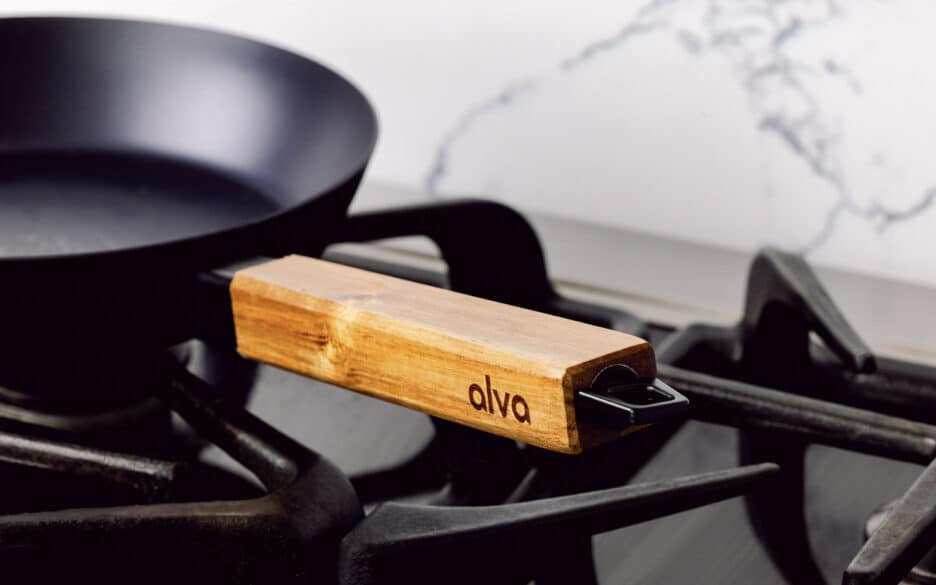
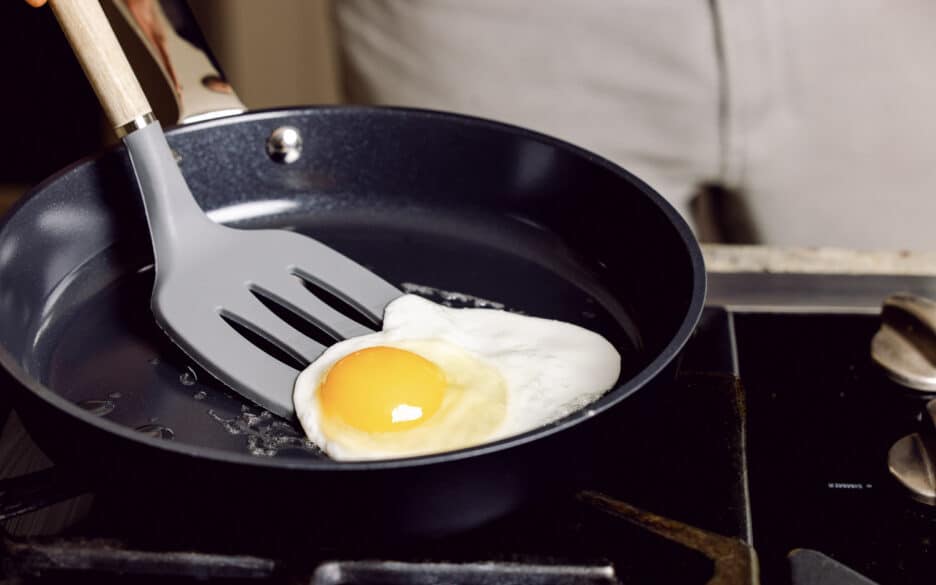


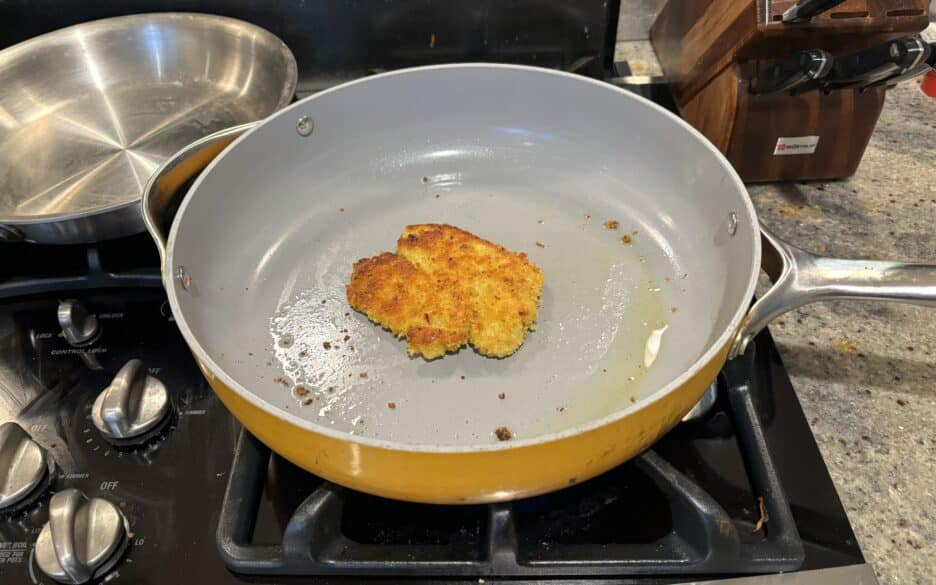

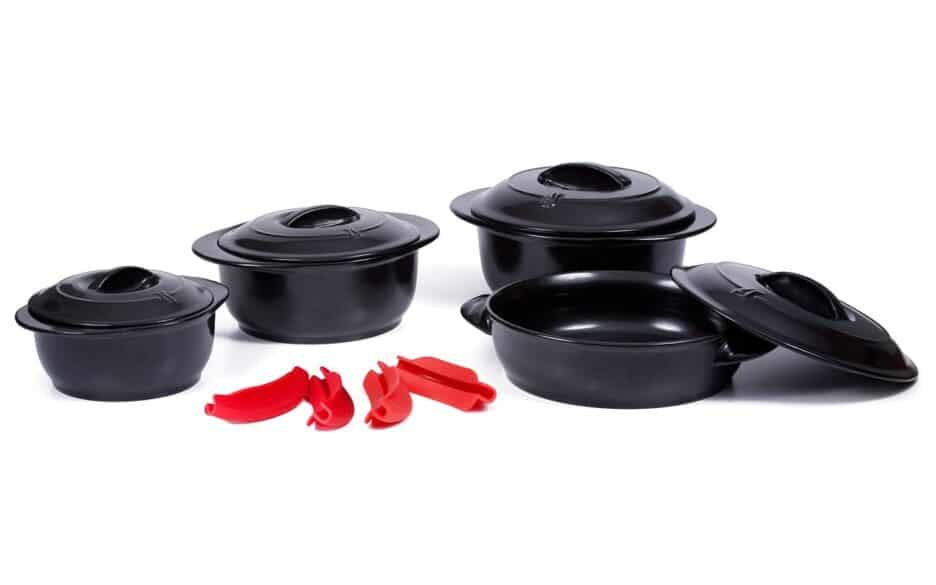
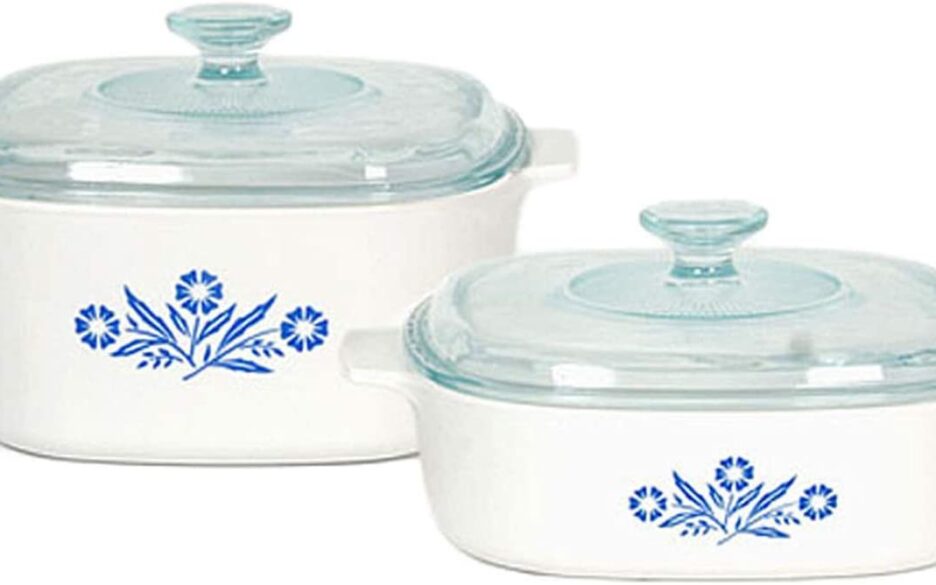
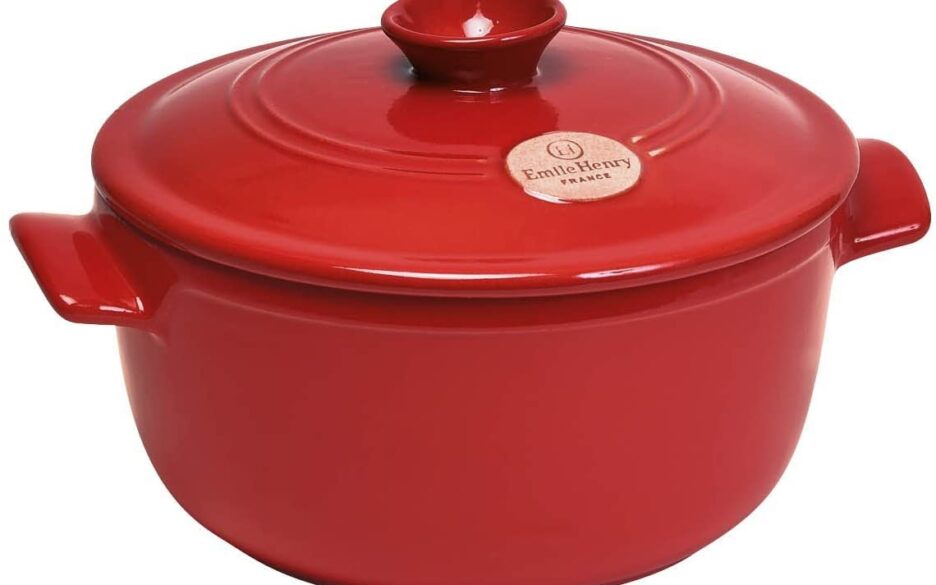
Quote from your review:
” Emile Henry dishes are designed to resist oven heat up to 480 F (250 C) but are not intended for use over direct flame or hot plates.”
The picture shows it on a gas stove, flame on!
Please remove Xtrema cookware (and also Emile Henry and GreenPan) from this list. Please do more research and you will find all of these have issues with toxicity. They are not non-toxic. Extrema contains neurotoxin lead as well as other toxins and is unsafe. Please see Tamara Rubin’s site Lead Safe Mama site for information about the scientific testing that was conducted to find this disappointing result.
We must all be aware, and not buy into the unsubstantiated claims of companies looking to capitalize on our concerns. There is no regulation that polices non-toxic advertising, and we are not protected. We must do our own research. Please do more and revise your recommendations.
Kate, thanks for the comment. Leigh wrote a dedicated blog post on Lead Safe Mama’s post about Xtrema, here: https://www.leafscore.com/eco-friendly-kitchen-products/cookware/xtrema-cookware-greenwashed-or-genuinely-non-toxic/
Very informative but the Lodge cart iron skillets have California proposition 65. Whereas this article says it dosen’t.
Hi Neetu,
I had a good root around online, including looking at Lodge’s website and specification sheets, but I don’t see a Prop 65 warning. Can you point me to where you saw this attached to the skillet, please? Thanks!
Leigh
Thanks for the great information. Have you researched the Blue Diamond pots and pans? Wondering you thought about safety.
Hi Wendy,
I took a quick look at Blue Diamond and can’t see any helpful information on the actual material composition of these pans. They also misuse the word ‘toxin’, which makes me suspicious that this is just greenwashing and not a credible non-toxic cookware option. Personally, I would avoid this kind of product and this kind of (forgive me) flash-in-the-pan company with no track record or clear information.
Thanks for asking!
Leigh
Can you tell me how Pampered Chef pans rate?
Really appreciate your thorough research! Thank you sooo much!
Just bought an expensive Cuisinart multiclad stainless steel pan to replace my 40 year old Farberware stainless steel frying pan. Have already burned myself on the metal handle! (Doesn’t anyone realize metal conducts heat?!)
Although under two percent of people have induction stoves, it seems every stainless steel company has jumped on induction bandwagon and is putting on those thick induction bottoms! This new bottom holds too much heat and I’m burning my food now. Tried to add more butter and oil however, so much crispy food is stuck to the pan, it is taking forever to wads the pan! Going to by an old used Farberware pan without an induction bottom. Boo induction bottoms 👎🏼
Exactly my thoughts: “Although under two percent of people have induction stoves, it seems every stainless steel company has jumped on induction bandwagon and is putting on those thick induction bottoms!”
Add to this that aluminium, which may be leaching from such bottoms, is toxic and so the entire construction must be thrown away as soon as you merely scratch it. Obviously, they want to make us buy more of their products by intentionally cutting their longevity short. I am looking for a well made non-chinese 100% single-ply stainless steel cookware in vain. Now, probably, I will have to turn to carbon steel. It rusts like hell though.
I’m looking for a really good non stick crepe pan for my mom. She makes crepes for my toddler often and has been using a regular non stick pan for years. I’m ok using a PTFE pan, as long as it’s free of PFOA. Even though non sticks will make this claim, one of your articles indicated that there were traces of PFOA often found. Do you know any brands of traditional Teflon type non stick that are truly PFOA free (even though made with PTFE)?
Violetta, we prefer pans that are PTFE and PFOA-free. Here are our current top picks: https://www.leafscore.com/eco-friendly-kitchen-products/best-non-toxic-nonstick-pans/
Leigh has tested Alva and that is what she uses at home.
Hello what do you think about the newest Greenpan GP5 cookware? It’s sold at Williams Sonoma. After reading about your review of Greenpan I will have to throw my skillets in the trash. Could you also look at Woll cookware? That’s my next pick
Thank you for your time.
What are your thoughts on MadeIn non-stick products and how do they compare to Caraway or Xtrema?
Hi Lynda, we don’t recommend the nonstick line from Made In because it contains PTFE. However, we do recommend Made In carbon steel and stainless steel, and tested both for this review: https://www.leafscore.com/eco-friendly-kitchen-products/review-made-in-cookware/
Hi Leigh,
I’m wondering if any old stainless steel pan is “clean”? The ones you list look awesome, but there are cheaper stainless steel pans that would fit our budget better…
Thanks!
Are “La Cintura di Orione by Alessi” and “All-Clad cookware” non toxic? If so, how many green leaves do they get?
You should only recommend based on scientific research, not home tests.
Thanks for the comment Eli. That is exactly what we do, we have been critical of several blog that have published at-home test results: https://www.leafscore.com/eco-friendly-kitchen-products/answering-reader-questions-about-caraway-cookware-and-greenwashing/
The brands listed here have all been transparent about the results of third party tests from serious labs.
Helpful article, thank you for all the great information! I’m trying to find PTFE free cookware, since I have a pet bird, and also want to reduce effects for the family, since I’m just learning about this. Lately Cuisinart has come out with another tri-ply stainless steel line called Cuisinart French Classic Tri-Ply Stainless. I bought a one quart pot to test it out. It’s a bit more expensive than the Multi-Clad series and seems to have better reviews. Have you looked into this line of stainless steel and what do you think? Would you add it to this list?
I don’t understand how you’re recommending caraway when earlier you said aluminum was bad for you and caraway pans are made of aluminum?
Hey Alice, Caraway uses aluminum in the manufacture of their pans to help conduct heat, but the cooking surface itself isn’t aluminum. Leigh wrote a long blog post on Caraway cookware and heavy metals in this post: https://www.leafscore.com/eco-friendly-kitchen-products/answering-reader-questions-about-caraway-cookware-and-greenwashing/
Hello,
Will the new ninja stainless steel cookware set be on the list ??
Hey Johanna, we have added Ninja to the research list, thank you for the comment!
I really appreciate the info here. I’m getting ready to update my 25 yr old stainless pans. I have a couple of le creuset non stick pro frying pans and a sauce pan. I love all three. Have you done any research on these pans? They also have a ceramic coated line that I like. If you haven’t checked these out, will you be adding them to your research list? Thank you so much!
Benny, the photo of the cookware on a gas flame is not Emile Henry. We tested Caraway and Xtrema on gas flames for the staff testing / first-hand experience portion of the reviews. Making sure we test the cookware ourselves is important to our readers.
Hi
I’ve come across a few nonstick ceramic coated cookware that I’m not seeing in any of your lists and were wondering if you’ve done any research on them.
1. ninja nonstick foodie
2. DaTerra Cucina Vesuvio cookware
3. Our Place ceramic cookware (always pan)
Thank you!
Val, Our Place Ceramic doesn’t make our list because of a lack of transparency in testing. We can’t confirm it’s PTFE free. Here is Leigh’s review: https://www.leafscore.com/eco-friendly-kitchen-products/cookware/always-pan-2-0-review/
Thanks Leigh! I value the research you offer here, and have read all the cookware articles. Deciding between Made In stainless steel and the Cuisinart stainless set listed above, obviously a big price difference. Could you please specify why the Cuisinart got 4/5 leaves instead of 5? My main priority/concern is no leaching, as I’m only cooking at home and do not necessarily need the most expensive option. Did Made In get 5/5 leaves because of less chance of leaching, or another reason? We make chili often so I want a pan that can handle some acidity. Many thanks again. Michelle
Tefal have a new line called ‘Natural Force’ that claims to be PFOA free, do you know if these are safe health wise? I don’t have the budget to buy your recommended pans and my choices are limited here in Portugal 🙁